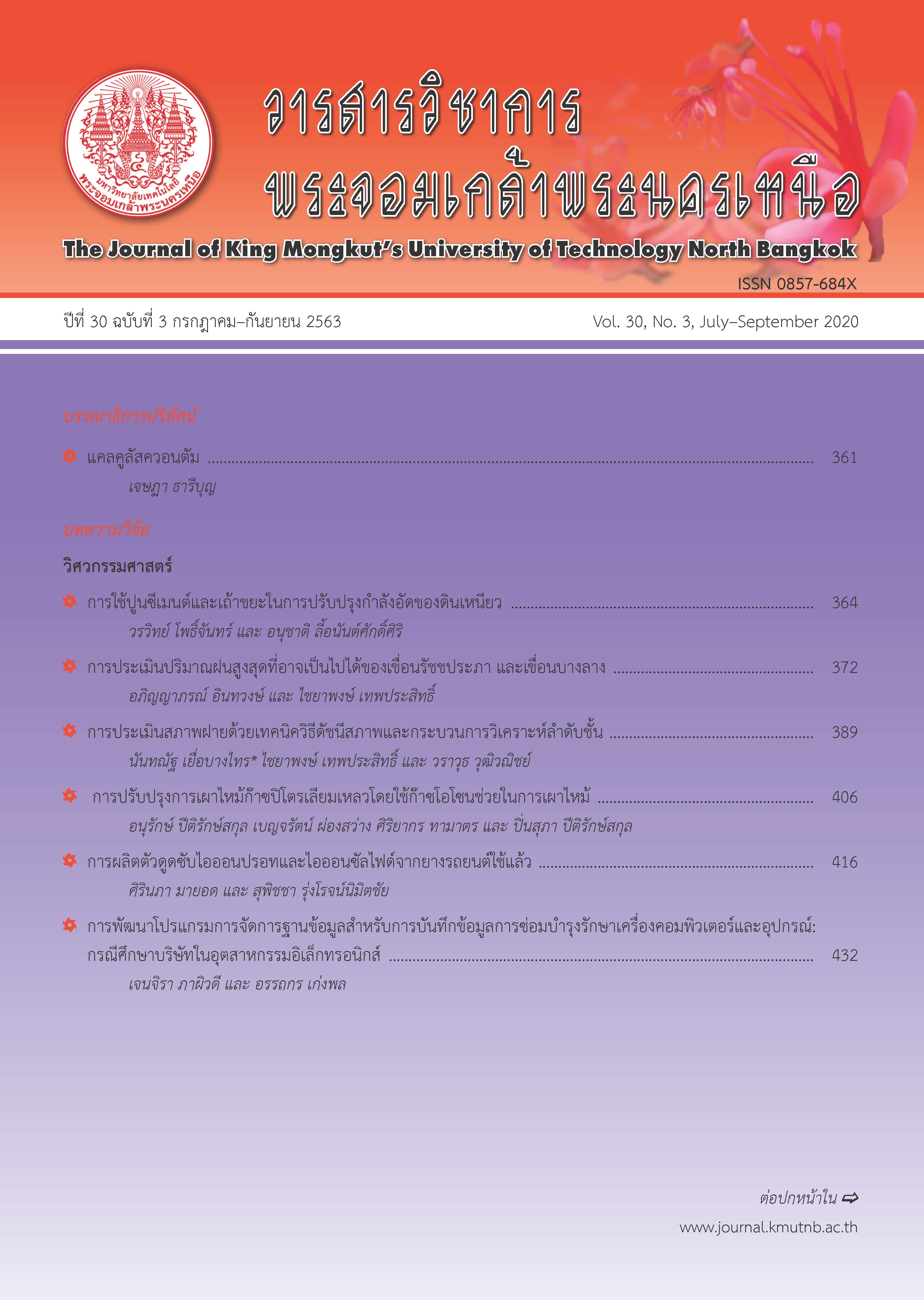โมเดลสมการเชิงโครงสร้าง เพื่อวิเคราะห์ปัจจัยที่ส่งผลต่อการคืนสภาพได้ทางไซเบอร์ของดิจิทัลซัพพลายเชน สำหรับวิสาหกิจขนาดกลางและขนาดย่อมในประเทศไทย
Main Article Content
บทคัดย่อ
การวิจัยครั้งมีวัตถุประสงค์เพื่อ 1) ศึกษาปัจจัยที่จะส่งผลต่อการคืนสภาพได้ทางด้านไซเบอร์ของดิจิทัลซัพพลายเชน 2) วิเคราะห์ความสัมพันธ์โครงสร้างเชิงสาเหตุของปัจจัยที่ส่งผลต่อการคืนสภาพได้ทางด้านไซเบอร์ของดิจิทัลซัพพลายเชนด้วยวิธีการวิจัยเชิงปริมาณ ตัวอย่างที่ใช้ในศึกษา ได้แก่ วิสาหกิจขนาดกลางและขนาดย่อม (เอสเอ็มอี) จำนวน 400 รายจากทั้งหมด 3,077,822 รายในประเทศไทย ผู้วิจัยทำการเก็บรวบรวมข้อมูลด้วยแบบสอบถาม โดยแจกแบบสอบถามเอสเอ็มอีละ 5 ฉบับ ผลการตอบแบบสอบถามกลับคิดเป็นร้อยละ 93.20 วิเคราะห์ข้อมูลด้วยการวิเคราะห์องค์ประกอบเชิงยืนยัน (Confirmatory Factor Analysis; CFA) และการวิเคราะห์โมเดลสมการเชิงโครงสร้าง (Structural Equation Modeling; SEM) ผลการวิจัยพบว่า 1) ความร่วมมือกันของดิจิทัลซัพพลายเชน (Path Coefficient = 0.11) การจัดการภัยคุกคามทางไซเบอร์ของดิจิทัลซัพพลายเชน (Path Coefficient = 0.03) และการจัดการความเสี่ยงทางไซเบอร์ของดิจิทัลซัพพลายเชน (Path Coefficient = 0.83) เป็นปัจจัยที่มีอิทธิพลโดยตรงต่อการคืนสภาพได้ทางไซเบอร์ของดิจิทัลซัพพลายเชนและมีอิทธิพลทางอ้อมต่อการจัดการความต่อเนื่องทางธุรกิจผ่านการคืนสภาพได้ทางไซเบอร์ของดิจิทัลซัพพลายเชน 2) ความร่วมมือกันของดิจิทัลซัพพลายเชน (Path Coefficient = 0.39) และการจัดการภัยคุกคามทางไซเบอร์ของดิจิทัลซัพพลายเชน (Path Coefficient = 0.59) เป็นปัจจัยที่มีอิทธิพลโดยตรงต่อการจัดการความเสี่ยงทางไซเบอร์ของดิจิทัลซัพพลายเชน และ 3) การคืนสภาพได้ทางไซเบอร์ของดิจิทัลซัพพลายเชน (Path Coefficient = 0.98) เป็นปัจจัยที่มีอิทธิพลโดยตรงต่อการจัดการความต่อเนื่องทางธุรกิจ โดยสรุปแล้ว การคืนสภาพได้ทางไซเบอร์เป็นสภาวะที่องค์กรมีความทนทาน คล่องตัว มีความสามารถในการรับมือและฟื้นฟูกลับคืนสู่สภาพปกติได้อย่างเร็วที่สุดหลังจากการถูกโจมตีทางไซเบอร์
Article Details
บทความที่ลงตีพิมพ์เป็นข้อคิดเห็นของผู้เขียนเท่านั้น
ผู้เขียนจะต้องเป็นผู้รับผิดชอบต่อผลทางกฎหมายใดๆ ที่อาจเกิดขึ้นจากบทความนั้น
เอกสารอ้างอิง
[2] P. M. Swafford, S. Ghosh, and N. Murthy, “The antecedents of supply chain agility of afirm: Scale development and model testing,” Journal of Operations Management, vol. 24, no. 2, pp. 170–188, 2006.
[3] Y. Meepetchdee and N. Shah, “Logistical network design with robustness and complexity considerations,” International Journal of Physical Distribution & Logistics Management, vol. 37, no.3, pp. 201–222, 2007.
[4] A. Luma, B. Abazi, B. Selimi, and M. Hamiti, “Comparision of maturity model frameworks in information security and their implementtation,” in Proceedings International Conf on Engineering Technologies (ICENTE'18), Konya, Turkey, 2018, pp.102–104.
[5] M. Christopher and H. Peck, “Building the resilient supply chain,” The International Journal of Logistics Management, vol. 15, no. 2, pp. 1–13, 2004.
[6] M. Windelberg, “Objectives for managing cyber supply chain risk,”International Journal of Critical Infrastructure Protection, vol. 12, pp. 4–11, 2016.
[7] A. Ali, A. Mahfouz, and A. Arisha, “Analysing supply chain resilience: Integrating the constructs in a concept mapping frame-work via a systematic literature review,” Supply Chain Management, vol. 22, no. 1, pp. 16–39, 2017.
[8] S. Parkinson, P. Ward, K. Wilson, and J. Miller, “Cyber threats facing autonomous and connected vehicles: Future challenges,” IEEE Transactions on Intelligent Transportation Systems, vol. 18, no. 11, pp. 2898–2915, 2017.
[9] N. Setthachotsombat, V. U-on, and R. Kaewthammachai, “Supply chain agility and supply chain resilience: An implementation for supply chainof computer industry in Thailand,” Academic Journal Phranakhon Rajabhat University, vol. 8, no.1, pp. 116–127, 2017.
[10] J. F. Hair, W. C. Black, B. J.Babin, and R. E. Anderson, Multivariate Data Analysis A Global Perspective, 7th ed., Pearson, 2010.
[11] S. Karnchanawasri, Applied Statistics for Behavioral Research, 3rd ed., Bangkok: Chulalongkron University Press, (2002) (in Thai).
[12] L. Petchroj and A. Chamniprasas, Research Methodology. Bangkok: Pimdeekarnpim, 2002 (in Thai).
[13] B. M. Byrne, Structural Equation Modeling with AMOS, 2nd ed., Taylor & Francis Group, (2010).
[14] R. Banomyong, “Collaboration in supply chain management: A resilience perspective,” International Transport Forum Discussion Paper, no. 2018–22, 2018.
[15] S. Hassell, P. Beraud, A. Cruz, and G. Ganga, “Evaluating network cyber resiliency methods using cyber threat, vulnerability and defense modeling and simulation,” presented at MILCOM 2012–2012 IEEE Military Communications Conference, 29 Oct.–1 Nov., 2012.
[16] J. Tupa, J. Simota, and F. Steiner, “Aspects of risk management implementation for Industry 4.0,” Procedia Manufacturing, vol. 11, pp. 1223–1230, 2017.
[17] L. Urciuoli. “Cyber resilience: A strategic approach for supply chain management, ”Technology Innovation Management Review, vol. 5, no. 4, 2013.

